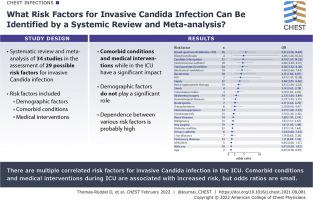Chest ( IF 9.6 ) Pub Date : 2021-10-18 , DOI: 10.1016/j.chest.2021.08.081 Daniel O Thomas-Rüddel 1 , Peter Schlattmann 2 , Mathias Pletz 3 , Oliver Kurzai 4 , Frank Bloos 1

|
Background
Current guidelines recommend empirical antifungal therapy in patients with sepsis with high risk of invasive Candida infection. However, many different risk factors have been derived from multiple studies. These risk factors lack specificity, and broad application would render most ICU patients eligible for empirical antifungal therapy.
Research Question
What risk factors for invasive Candida infection can be identified by a systematic review and meta-analysis?
Study Design and Methods
We searched PubMed, Web of Science, ScienceDirect, Biomed Central, and Cochrane and extracted the raw and adjusted OR for each risk factor associated with invasive Candida infection. We calculated pooled ORs for risk factors present in more than one study.
Results
We included 34 studies in our meta-analysis resulting in the assessment of 29 possible risk factors. Risk factors for invasive Candida infection included demographic factors, comorbid conditions, and medical interventions. Although demographic factors do not play a role for the development of invasive Candida infection, comorbid conditions (eg, HIV, Candida colonization) and medical interventions have a significant impact. The risk factors associated with the highest risk for invasive Candida infection were broad-spectrum antibiotics (OR, 5.6; 95% CI, 3.6-8.8), blood transfusion (OR, 4.9; 95% CI, 1.5-16.3), Candida colonization (OR, 4.7; 95% CI, 1.6-14.3), central venous catheter (OR, 4.7; 95% CI, 2.7-8.1), and total parenteral nutrition (OR, 4.6; 95% CI, 3.3-6.3). However, dependence between the various risk factors is probably high.
Interpretation
Our systematic review and meta-analysis identified patient- and treatment-related factors that were associated with the risk for the development of invasive Candida infection in the ICU. Most of the factors identified were either related to medical interventions during intensive care or to comorbid conditions.
中文翻译:

危重患者侵袭性念珠菌感染的危险因素
背景
目前的指南建议对具有高侵袭性念珠菌感染风险的脓毒症患者进行经验性抗真菌治疗。然而,从多项研究中得出了许多不同的风险因素。这些风险因素缺乏特异性,广泛应用将使大多数 ICU 患者有资格接受经验性抗真菌治疗。
研究问题
通过系统评价和荟萃分析可以确定哪些侵袭性念珠菌感染的危险因素?
研究设计和方法
我们搜索了 PubMed、Web of Science、ScienceDirect、Biomed Central 和 Cochrane,并提取了与侵袭性念珠菌感染相关的每个风险因素的原始和调整 OR。我们计算了一项以上研究中存在的风险因素的汇总 OR。
结果
我们在荟萃分析中纳入了 34 项研究,评估了 29 种可能的风险因素。侵袭性念珠菌感染的危险因素包括人口因素、合并症和医疗干预。尽管人口因素对侵袭性念珠菌感染的发展没有影响,但合并症(如 HIV、念珠菌定植)和医疗干预具有显着影响。与侵袭性念珠菌感染的最高风险相关的危险因素是广谱抗生素(OR,5.6;95% CI,3.6-8.8)、输血(OR,4.9;95% CI,1.5-16.3)、念珠菌定植(OR,4.7;95% CI,1.6-14.3),中心静脉导管(OR,4.7;95% CI,2.7-8.1)和全胃肠外营养(OR,4.6;95% CI,3.3-6.3)。然而,各种风险因素之间的依赖性可能很高。
解释
我们的系统回顾和荟萃分析确定了与 ICU侵袭性念珠菌感染风险相关的患者和治疗相关因素。确定的大多数因素要么与重症监护期间的医疗干预有关,要么与合并症有关。


























 京公网安备 11010802027423号
京公网安备 11010802027423号